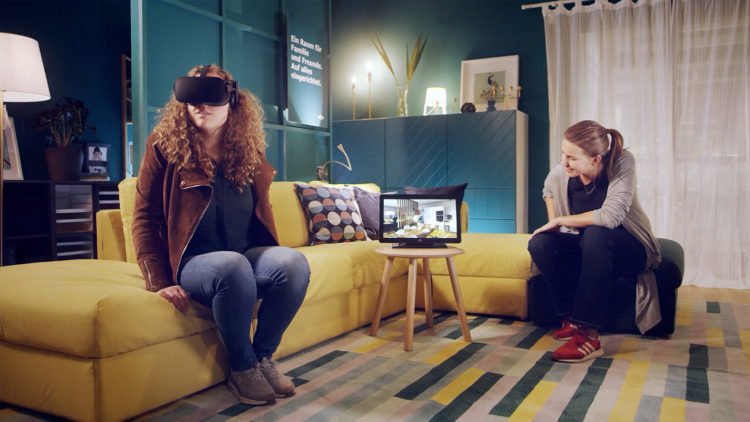IKEA Immerse
The IKEA Immerse app is available in selected IKEA stores in Germany. This benchmark design application enables consumers to create, experience and share their own configurations in a virtual living and kitchen room set. With its seamless ecommerce integration, a high level of detail and real-time interaction, the spatial computing in VR experience represents an engaging and valuable touchpoint.
A multifunctional use case strategy
The application is a crucial part not only in IKEA’s omnichannel strategy, but also in the digital transformation of its point-of-sales. It is the successor of the 2016 IKEA Virtual Home experience, that has been tried and tested as a prototype application in an IKEA Store in Berlin six days a week for over a year. Based on about 25,000 users, detailed analytics and intensive user studies, we developed the new application iteratively and brought it to market for in-store as well as pop-up, event and home use cases.
Strategically integrated in consumer journey
Not only did we aim to support several touch points, our goal was to deliver rich interaction and a broad range of configuration varieties. Based on this, IKEA Immerse is set up to elevate the brand experience by fostering co-creation and conversion. It is integrated in the consumer journey and core business areas. Customers are enabled to favorite or purchase products on their smartphone. A panorama of their personal room is made available for sharing.
Real-time configuration with immersive storytelling
The extent of freedom that this application offers is unsighted: Hundreds of configurations, options and combinations can be experienced in any daytime situation. This virtual room is never quite the same and invites to play, configure, share and come back again. The IKEA brand experience is elevated by a storytelling concept that makes use of the brand testimonials Jonas and Smilla, guiding users by voiceover during the onboarding as well as throughout the whole experience process.
An agile concept and production pipeline
We aimed to bring this virtual world to life in a real time application with utmost visual and interactive brilliance. Hence, we established an agile team of creative concept, experience designer with focus on story, art and sound - closely collaborating with 3D artists, interactive producers and creative engineering. After an initial phase of analyzing user studies and exploring several interior design benchmarks, we chose an unique technical route: The concept is a hybrid of real-time rendering, specifically adapted models and textures, real-time lights, pre-rendered lightmaps as well custom shaders and visual effects. The intuitive UI and interaction design from the first VR application was redesigned for new interactions and rich contents.

Real-Time and Seamless Technical Framework
An agile kanban workflow ensured fast prototyping, change management in line with IKEA’s product managers and interior designers as well as ongoing quality assurance. The development and 3D modeling pipeline was very complex: Existing 3D data was optimized in an extensive retopology process, thereby minimizing polycount, optimizing meshflows and geometry for the development concept. Test an tried directly in unity and on the store infrastructure, flawless real-time rendering performance was ensured. The post-processing was executed in team art direction and engineering, based on light moodboards, benchmarks and real room personas.

Relevant and Adaptable Contents
Needless to say, hero contents, accessoires and key contents such as outdoor panorama, SFX, onboarding, storytelling voiceover can be modified for any location and refreshed with a minimum amount of work. The overall built is easy digestable for remote servicing and continious updates in the Oculus Store. Furthermore, an adaptable idle mode on the in-store 2nd screen can be used to vary call to actions and onboardings in store. Whether at the IKEA catalog launch event, in german retail stores or - coming soon - in the Oculus Store: The application is modified for target audiences and use case.
Social Interaction and Takeaways
Focussing on relevance, we sought to create an application without dead ends - enabling interaction within groups of users, shareability and integration into the IKEA sales funnel were key. The In-Store 2nd screen, a shareable room panorama and the transfer of the configuration into the mobile shopping list are the cornerstones of this concept. In what way - and to what extent - these features are used, is helping IKEA to build up further knowledge, how VR will integrate into the realm of interior design, product configuration and personalization. Therefore, qualitative and quantitative analytics are evaluated with the IKEA product owners on a weekly base.
Custom Lighting and Shading
Immersion is maximized by a combination of factors: Social interaction, realistic and persuasive SXF on roomscale - and last, but not least: Visual brilliance. In real-time rendering, this is achieved via a multitude of factors. Materials do need custom textures and lightmaps in each and every daytime, a range of visual effects and refinements such as anti-aliasing, fresnel and reflections in every detail. Our engineering and 3D art team created several sets of probes for materials that very iteratively enhanced - in steady comparison with real objects and light situations. This guaranteed, that even from close up, surfaces such as wood, metal and glass appeal as realistic as possible, ensuring a benchmark virtual reality experience in real-time.
On the road towards a Sales Tool
Being established in retail environments as a part of the consumer journey, our Virtual Reality experience will now aim to reach the plateau of productivity. This means providing a sales tool, that inspires consumers, enables them to explore products with their friends and family, to share configurations on social media - and most of all: To shop configured products in-store or online. This too will be a process of learning and refining, thereby creating a new shopping experience.


















